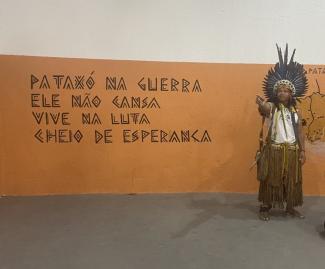“Place of Memory:” Renovation and Restoration of the Pataxó Indigenous Museum
23 September 2024Diana

The Museu Indígena Pataxó de Coroa Vermelha, located in the municipality of Santa Cruz Cabrália, Bahia, was initially constructed in the 1990s in celebration of the “500 Years of the Discovery of Brazil,” though it lacked meaningful engagement with Indigenous Peoples and long-term planning, and its exhibition represented Indigenous Peoples in a very generic way. After commemorating two significant 500-year anniversaries, the museum gradually fell into neglect and disrepair by the responsible authorities. The local community, especially the Associação dos Comerciantes do Parque Indígena de Coroa Vermelha, endeavored to keep it running, but by 2018, the museum’s operations were suspended indefinitely due to challenges in sustaining its upkeep. Due to its significance, the local Pataxó community of Coroa Vermelha and the Association have always wanted to rebuild it. “For the past two decades, the museum has distorted our ancestral and cultural memories. Now, the new museum demonstrates our commitment to safeguarding our heritage. It has become a space that reflects the experiences and holds the mourning of the Pataxó people… it serves as a means of resistance for a community that continues to affirm its cultural identity,” says Oiti, a member of the Pataxó community in Bahia.
The Indigenous Pataxó Peoples were among the first to have contact with Portuguese settlers. They speak a modernized version of their native language, known as Patxohã. In 1961, they were evicted from the largest remaining forest area by State-run companies and forced into the dominant society, causing them to lose much of their Indigenous territories and way of life. Some Pataxó moved to coastal regions and established new Indigenous communities, such as Coroa Vermelha, which was founded in 1972 and is now home to about 5,000 people.
Much of the Pataxó Peoples’ ancestral lands were transformed into private farms by settlers, and they continue to face threats from real estate developers, multinational agribusiness corporations, farmers, and ranchers. The effects of the notorious Marco Temporal (temporal framework), although legally rejected by Brazil’s Supreme Court in 2022 and criticized by international human rights organizations, still persist, instigating land grabs and violence against the Pataxó community. Most recently, three Pataxó leaders were shot during an attack earlier this year by farmers attempting to “reclaim” Pataxó traditional territory. Witnesses confirmed that the Military Police of the state of Bahia actively participated in the attack on the community.
Amid ongoing violence and destruction, the restoration and renovation of the museum holds great social, cultural, and political significance. Its restoration connects different groups within the community and fosters collective healing. It is a project that “takes a village,” including the young generation, Elders, leaders, teachers, students, and various organizations. Reconstructing the narratives of territorial occupation, struggle, displacement, return, and repossession required both the youth and the Elders, as well as Indigenous researchers. Together, they rescued and collected arts and crafts. They also searched for documents and journals that represent the cultural heritage of the Pataxó people and cataloged them for chronological display.

Now, the museum is poised to commence new exhibitions, establishing itself as a vital place of memory for the community, affirming its culture, and strengthening its identity. Moreover, it has resumed its function as a tourist site, bringing significant economic benefits to the community. For the local community, it has become a center for gatherings, cultural events, and educational programs. For non-Indigenous visitors, it serves as a platform to educate them about Pataxó history and culture and raises awareness regarding pressing issues, fostering greater respect. Unlike its original construction, which was done mainly by regional and federal authorities, the Pataxó community of Coroa Vermelha has led the entire process, ensuring their cultural heritage is accurately and authentically presented. This is a direct challenge to settler-colonialist paradigms and perceptions of Indigenous Peoples, reclaiming agency in the representation of the Pataxó People.
Arissana Pataxó (Pataxó), who participated in the museum’s restoration, says, “Creating a collection, even a provisional one, for a space like a museum is very time consuming and requires significant research and financial resources. Therefore, carrying out this exhibition curation in a limited amount of time and with limited financial resources was very challenging for us. But the experience was rich since I was able to collaborate with the community and contribute to the memory and valorization of the arts of the Pataxó People.”
